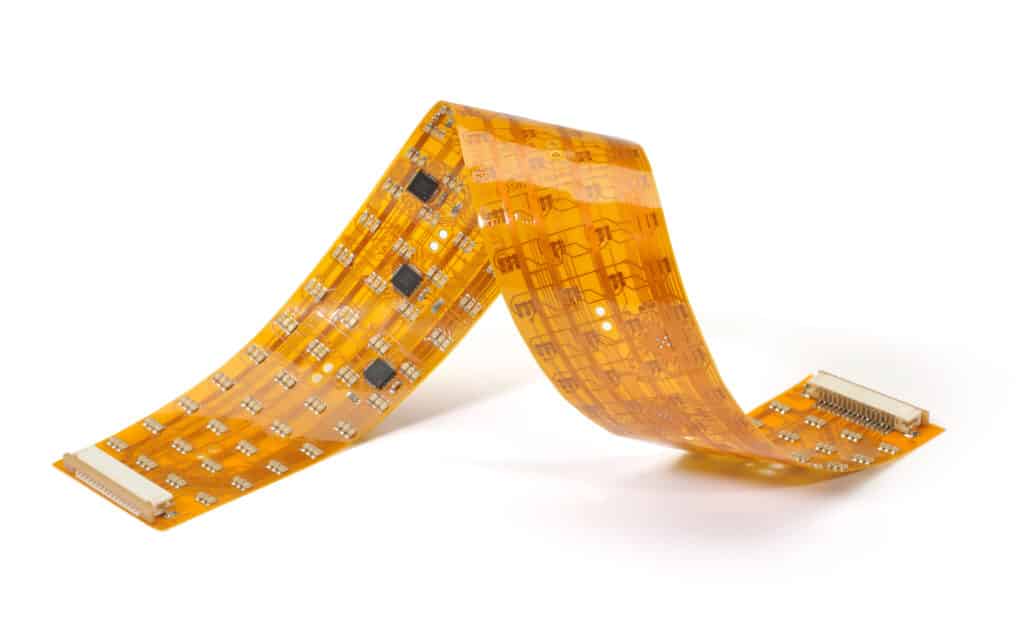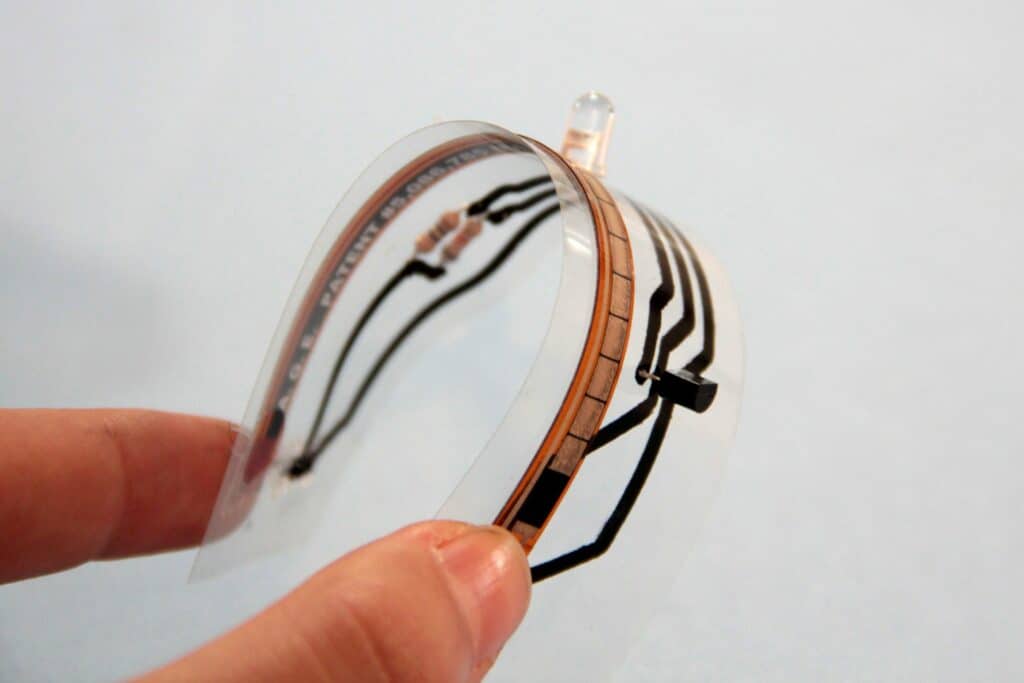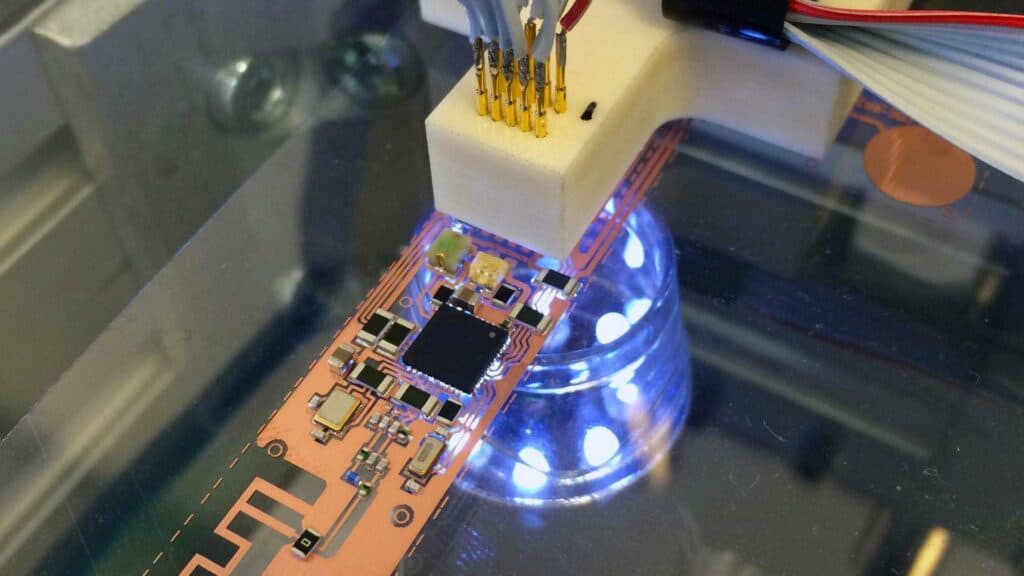In the initial stage of rigid flex PCB design, it is of great importance to consider some choices. Cost optimization is necessary in rigid flex PCB design and manufacturing. The choices made will affect PCB design. Also, some choices will lead to reduced costs while still maintaining high performance and reliability.
We will focus more on the factors that determine the cost of rigid flex boards. Also, we will look into how to reduce the overall cost of a rigid flex PCB.

What is a Rigid Flex PCB?
A rigid flex PCB is a type of circuit board that features enough flexibility and strength. This PCB features more flexibility than a rigid printed circuit board. A rigid flex PCB is a combination of a flexible PCB and a rigid PCB. A rigid flex PCB has the flexibility of a flex circuit and the strength of a rigid circuit board. Some rigid flex designs require the combination of multiple flex circuits attached to many rigid PCBs.
One unique advantage of a rigid flex PCB is that you can place the rigid part of the board in the application. Also, you can fold or bend the flexible part around the components to make another connection. Therefore, this enables a good connection between parts. Examples of electronic devices that integrate rigid flex PCBs include wearables, laptop computers, and smartphones.
One difference between a rigid PCB design and rigid flex circuit is the low amount of prepreg used. Also, rigid flex PCB manufacturing is more expensive than rigid PCBs or flexible PCBs. However, the assembly process is a simple one. Also, rigid flex PCB minimizes board-to-board connectors and solder joints.
Rigid flex PCBs are ideal for use in a wide variety of applications. The flexible laminates in rigid flex PCBs are specifically designed to be always flexible. Also, they are usually transformed into flexed curve during manufacturing. Rigid flex PCBs are carefully designed in a 3D space. Also, the use of 3D design makes it easy for designers to fold, bend, and twist the flexible substrates to get the desired shape.
A rigid flex printed circuit board can resist thousands of flex cycles without experiencing any failure. The flexible and rigid substrates create an integrated unit which you can manipulate into a 3D subassembly.
Cost Drivers of Rigid Flex PCB
There are certain factors that contribute or determine the cost of rigid flex circuits. When designing a PCB, one of the main objectives is cost optimization. Therefore, every PCB designer must understand those factors that drive the cost of rigid flex PCB.
PCB Materials
The material type useful for the fabrication of a circuit board contributes to rigid flex PCB cost. Also, there are several factors that affect these materials. These factors include thermal stability, thickness, and flexibility. The primary materials integrated in fabricating rigid flex PCB are fiberglass laminate, FR4, and flexible epoxy laminate.
These materials are suitable for rigid flex PCBs since they ensure enough flexibility and strength. Mechanical properties mainly influence the property of flex circuits. Such examples include bending strength and flexural strength. Also, the board’s thickness plays a crucial role in the flexibility provided by a rigid flex PCB.
Number of Layers
Rigid flex circuit boards feature multiple layers also. Therefore, PCB manufacturers should ensure they put layers together to create a circuit board that offers both strength and flexibility. As a result, the number of PCB layers must be suitable for the strength and flexibility of this board. Furthermore, the thickness of each layer will impact the number of layers in a PCB.
Also, the number of layers influences the cost of manufacturing since it is important to build the PCBs from the bottom. Therefore, the PCB will need to withstand strength and flexibility. The overall cost of a rigid flex PCB will increase as the number of layers also increases. Also, the more layers will make the lamination process a complicated one.
Surface Finish type
The type of surface finish you use for a rigid flex circuit has an effect on the overall cost of the board. Also, finish impacts the overall performance and properties of a rigid flex circuit board. For example, a transparent layer is suitable for finishing a flex circuit. This will enable the transmission of light.
HASL is the most preferred surface finish for rigid flex printed circuit boards. Also, HASL process is very simple to carry out. Other commonly used surface finishes include OSP, ENIG, and ENEPIG. Some surface finishes are more expensive than the other. Therefore, the cost of surface finish you use will impact the cost of rigid flex circuit boards.
Minimum space and trace
Trace width and spacing can affect the cost of rigid flex PCB. There is a right trace width needed for signals propagation through a trace. If the spacing is tighter, this will be very difficult to etch pads and traces. Also, the space and trace of a board is the distance between the size of the copper lines and every copper layer. The trace is the copper lines’ width while the space refers to the distance between layers.
PCB thickness and aspect ratio
The relationship between the width and length of a PCB is the aspect ratio. Therefore, aspect ratio is calculated by dividing length by the width. Also, there are several factors that determine the aspect ratio of a rigid flex PCB. This includes the board’s thickness. The rigid flex board’s thickness must ensure that the overall rigidity of the circuit board is sufficient. Furthermore, thick rigid flex circuit boards are more stable.
The standard thickness of a rigid flex PCB should be within the range of 3.2 mils to 3.4 mils. It is, however, important to take the manufacturing costs into consideration. Smaller thicknesses are better when they are more cost effective flex circuit than large thicknesses.
How to Minimize the Cost of Rigid Flex PCB Design

It is possible to reduce manufacturing costs rigid flex PCBs. There are several ways to do this. You can tailor some factors to meet your required specifications.
Maintain a minimum amount of flexible layers
Rigid board laminates are less expensive than flexible circuits’ laminate. Therefore, you can minimize the rigid flex PCB manufacturing cost by reducing the number of layers of flexible circuits. Also, the flexible layers are usually designed separately from the final board.
Use fewer parts when performing mass manufacturing runs
When performing mass manufacturing runs, manufacturers can’t save on the parts used for the circuit boards. However, there are some ways to go about this. For instance, you can improve the yield factor by integrating single sided PCBs instead of double sided PCBs. Since double layer PCBs need more copper, there will be a fewer parts.
Limit the requirements for controlled impedance
We understand how manufacturers could wish to define all the impedance values. However, PCB manufacturers need to fabricate rigid flex PCBs based on the limited impedance requirements. Therefore, manufacturers must ensure they meet these requirements irrespective of the surroundings and environment.
Integrate rigid board laminates to achieve PCB thickness
Sometimes, it can be difficult to get the required PCB thickness. However, there are rigid board laminates that can help you achieve this. These laminates help you create thicker circuit boards. Also, they are flexible enough to meet twisting and bending requirements.
Use specialized processing
Some techniques used in rigid printed circuit board designs help to achieve good yields. However, these techniques can be difficult to use in rigid flex designs. Also, they cause lower manufacturing yields. However, there are advanced processing that can help to achieve excellent yields.
Guidelines for Rigid Flex Circuit Board Design
A rigid flex PCB design will look like a hardboard design. Just like rigid printed circuit boards’ layouts, the fabrication of rigid flex PCBs will include solder mask layers, Gerber layers, coverlayer, etc. However, there are some difference between rigid flex PCB fabrication and hardboard applications.
- Rigid flex PCBs features more dimensions. These dimensions define the requirements. Also, you should define the flex to rigid transition areas.
- The layup of material in rigid flex PCBs is crucial. Therefore, it is important to work with your fabricator. A good fabricator will help you choose the right materials. Also, the choice of materials will be in line with some requirements like UL flammability rating, lead free assembly, and RoHS certification.
- Rigid flex PCBs always need extra layers in the Gerber files. Also, you need artwork layers. These layers will help you define the bondply sections and coverlayer of the board.
Material Layup Considerations for Rigid Flex PCB

Rigid flex material layups affect cost, performance, and manufacturability. Therefore, it is critical to determine the suitable material set. For example, current-carrying requirements, controlled impedance, and resistance are crucial considerations that have an impact on copper weights.
A PCB designer should discuss these crucial variables with their board fabricator. This will helps the resulting design meet the requirements for signal integrity. Also, the PCB fabricator can verify the requirements after the designer has carried out initial calculations.
The rigid flex cost estimator can help you to quickly estimate the manufacturing costs of rigid flex PCBs. Also, this estimator will consider all your requirements and provide an estimated cost for low quantities’ production.
In addition, the rigid sections of rigid flex printed circuit boards are always 20 layers or less. However, there can be over 20 layers in some cases. This is very rare. The rigid board sections don’t need to have exact layer count. For instance, there could be a rigid section having 16 layers and another could have 12.
It is only important for the material layup to be similar. Also, the boards should have similar overall thickness. Sometimes, a PCB design may integrate rigid boards that have different thicknesses. However, these configurations are more complex to manufacture.
The flexible parts of rigid flex boards comprise one, two, three, or four layers. In some cases, a PCB design may need over four layers across the flexible areas of the PCB. However, these layers are always unbounded. Also, bonded flex sections with over four layers can be difficult to bend or flex. The flexible layers of rigid flex laminates have copper weights that are commonly measured at one ounce.
Cost Saving Advantages of Integrating Rigid Flex PCBs
There are several benefits of using rigid flex PCB. Asides from its technical benefits of using these printed circuit boards, there are cost saving benefits. Also, the integration of rigid flex printed circuit boards in your projects can reduce cost while allowing better performance. Rigid flex boards are now widely used across several industries like military, consumer electronics, and medical. Below are some cost saving benefits of integrating rigid flex PCBs.
Reduced space requirements
A rigid flex PCB integrate thin polyimide films. This means that the PCB size can accommodate a smaller area of space. Therefore, this enables manufacturers to shrink and minimize the required packaging size for the final PCB. Therefore, this helps to save cost.
Simplifies PCB assembly
With rigid flex circuit boards, you can enjoy benefits of simplified PCBA process. This is because you can merge several circuit boards in one design. Also, you can run one assembly instead of two. Furthermore, a simplified PCB assembly process makes room for less error. Therefore, with fewer errors, you can save more cost on fixing potential defects.
Ability to merge designs
Rigid flex PCB manufacturing allows the merging of several circuit boards in one design. Therefore, this helps to reduce the cost of fabricating rigid flex PCBs.
Minimizes testing costs
A rigid flex PCB helps you to save cost on testing. This is because rigid flex circuits require just one test operation. In addition, this board offers the capability to test the assembly before installing it.
In general, a rigid flex PCB offers various cost-saving advantages. Also, this board has proved to be a cost-effective solution in various applications.
Conclusion
Rigid flex PCBs have provided several benefits when used in various applications. Also, these circuit boards have proved to be a perfect option in some applications. They combine the strength and flexibility of a flexible printed circuit board and rigid circuit boards. During rigid flex PCB design, it is important to take into account some considerations.
However, these PCBs are becoming more complex. This is as a result of more requirements being demanded from various applications. It is crucial to always consider cost optimization at the initial stage of rigid flex PCB design.

